Pandemic Ad-pocalypse: Why Are Advertising Giants Struggling While PostcardMania Thrives?
Updated on July 15, 2021Unless you’re a marketing nerd like me, you probably haven’t heard of the Ad-pocalypse. What with the pandemic, social rights revolution, the government confirming that ALIENS ARE REAL (no really, Google it), and giant hornets invading the US… you might’ve missed a few news stories.
In short, digital advertising giants are taking a massive hit this year.
A quick breakdown of some numbers:
- Twitter = down 23%.
- Google = down 10%.
- Facebook = up 11%. (Okay okay, BUT that’s down from its usual 25% quarterly growth.)
Yet little ol’ PostcardMania just had 2 of our highest-EVER sales months back to back. June and July were bananas here — and it’s usually our slow season!
I had to ask…what gives?! Why are we killing it while these tech titans post big revenue losses?
I’ll tell you if you keep reading!
So, what’s the deal?
Is direct mail more effective now that people are at home more, something small business owners have tapped into?
Are people just totally tuning out digital ads now that we’re streaming more digital content than ever?
Is it because some of these ad giants cut their marketing budgets when things turned south?
The numbers don’t lie — only one of these reasons is the underlying cause for the declines above.
Let’s break it down:
Is direct mail more effective now that people are at home more, something business owners have tapped into?
Wellllllll, response rates HAVE improved year after year consistently for the past several years, and direct mail puts up jaw-dropping response rates. In the latest DMA report, they found:
- In 2018, direct mail’s average response rate amounted to:
○ 4.9% for prospect lists
○ 9% for house lists
○ This is significantly higher than response rates in 2017 when direct mail earned 2.9% and 5.1%, respectively.
- Compared to the 9% house lists response rate, email, paid search, and social media have only a 1% response rate
Reread that last bullet again. Go ahead, I’ll wait.
If you combine the response rates of email, PPC, and social media, and THEN tripled that amount, it would only then be as effective as direct mail.
Think about a foot race between Usain Bolt and your grandma.

If you were looking for a more *practical* visual, here you go.
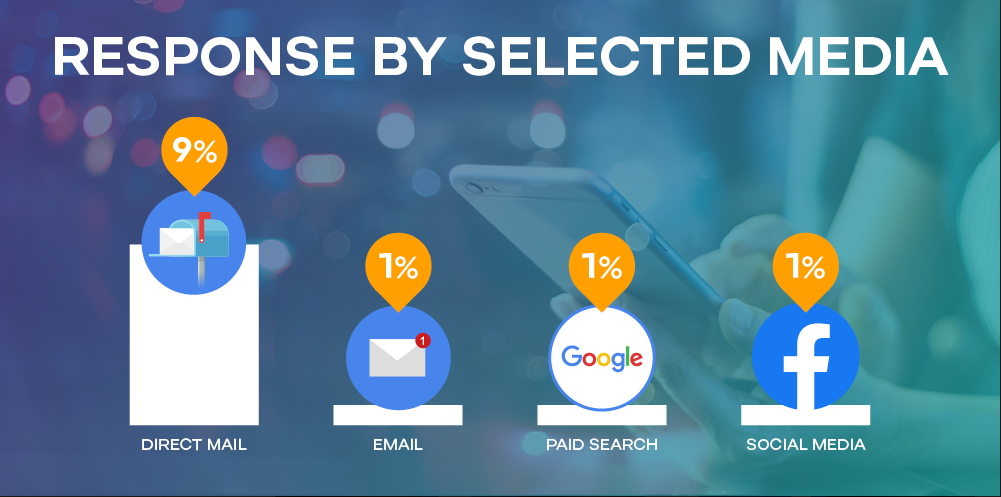
You get the point.
While I definitely think this is a contributing factor, it definitely isn’t the root of our success. Let’s keep digging, shall we?
Are people desensitized to digital?
The data shows us that digital media consumption is way up. This year, emarketer found that US consumers’ average time with media will increase by more than 1 hour per day, to 13 hours, 35 minutes. Axios estimates that children’s use of digital media this year is at a 70% spike.
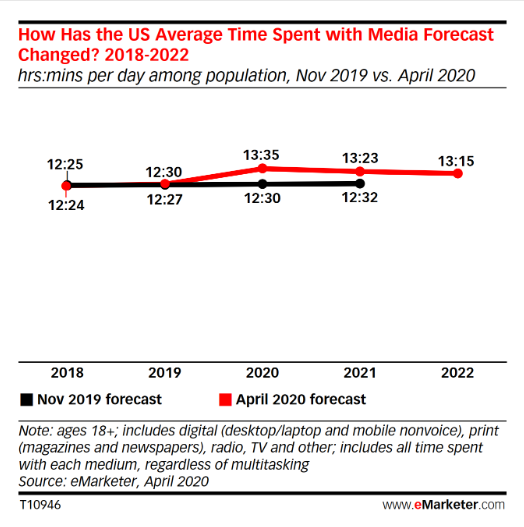
That’s a loooot of time to be staring at a screen if you ask me — how is a digital ad going to invoke excitement in you if you see a bajillion of them a day?
BUT, we can’t say for sure. Is it likely a contributing factor? I say yes.
But here’s the real reason why our numbers and pandemic rebound are trumping even the largest ad companies in the world…
They cut their marketing and we didn’t!
Here’s the evidence we’re looking at to back up this claim…
#1: The numbers show that everyone but Facebook cut their marketing — and numbers don’t lie.
So let’s backtrack and take a closer look at these tech giant numbers. Keep in mind, for many years, these digital advertising dominators have usually reported at least double-digit quarterly percentage gains in ad revenue.
Twitter’s second-quarter advertising net revenue fell off a cliff. It totaled $562 million and was down nearly a quarter (23%) compared to last year’s (yikes). Their marketing budget after the second quarter was $446,048 in 2019, while this year, at the same time, it was marked at $428,573.

Alphabet (Google’s parent company) second-quarter earnings were marked at $38.94 billion in 2020, a decline of 2% from $41.80 billion in 2019. That’s a loss of almost $3 billion. This undoubtedly reflects what is happening at Google – this second quarter is thefirst time ever that they experienced a drop in advertising revenue. Their marketing budget is reported to be cut in HALF (to reiterate – 50%!!) for the rest of this year. Whoa.
Facebook is faring the best out of the three, being the only one to sustain any kind of growth, even despite the ad boycott. They’ve been able to pull off a 10% advertising revenue growth, jumping from $16 million to $18 million.
What sets it apart?
Instead of decreasing their marketing budget, they increased it from 4.4 million in 2019 to 5.6 million this year!
You know who else didn’t cut their marketing spend, despite a massive revenue hit? Lil’ PostcardMania wasn’t looking so hot at the beginning of the pandemic; our weekly revenue was down 41%. We stayed the course, and because of it, we are now back in the black!
#2: Multiple experts and experience repeatedly demonstrate that cutting marketing = cutting sales.
This isn’t some conclusion we plucked out of thin air.
There’s a clear correlation between a company’s marketing and their number of sales and total revenue. While it normally isn’t this drastic, the international economic insecurity that stemmed from the pandemic has exacerbated this correlation.
One of the best in the analytical biz, The Harvard Business Review, conducted in-depth research surrounding how businesses responded to the last economic recession in 2008 and the eventual effects of those decisions.
They found that “Companies that injudiciously slash marketing spending (during an economic downturn) often find that they later must spend far more than they saved in order to recover from their prolonged absence from the media landscape.”
This “media landscape absence” applies to small businesses as well – just on a local scale.
You never know with these topsy-turvy things, but if I were to guess, they will report similar findings when they dive into how companies responded to this economic downturn.
Informational titan Forbes recently released an article detailing why businesses need to market MORE in an economic recession, not less.
Former Microsoft executive and current MDC Partners CEO Mark Penn in an interview with AdWeek detailed how a company’s marketing is the most significant indicator of why they’re struggling or thriving in the pandemic.
In another interview with Fox Business, he discusses how vital marketing will be for the economy’s recovery.
And finally, my personal favorite…drumroll…

US! Your friendly neighborhood postcard marketing experts!
One of our core philosophies here is that we never slow our marketing, no matter what’s going on in the world.
Months before the pandemic’s major effects, I wrote a Forbes article about what I learned from spending $70 million on marketing.
The very first lesson (literally!) is this:
Lesson 1: Any decrease in your overall marketing can have a similar effect on your revenue.
This philosophy comes from previous experience. The mistakes you make are usually your best teachers.
My mistake almost cost me my business. A year after the 2008 recession, I was just like many of you out there right now: in a perpetual state of anxiety, frantically searching for what we could do to make ends meet.
An advisor told me we could save a fortune cutting back on our marketing budget, so I did just that against my better judgment.
Because of that decision, new incoming leads and revenue took a nosedive – the company was surviving on a week-to-week basis. I could just barely cover payroll.
The solution? I think you can probably guess.
MARKETING!!!! For me, that looked like ramping up my direct mail marketing budget back to its pre-crash total. As a result our numbers eventually recovered, and we began growing again. Since money was so tight, this was no easy task – I made marketing and payroll my top priorities and walked the tightrope with my other bills – scary times, but worth it!
At the end of the day, it comes down to this.
Recession marketing (or really any marketing for that matter) is all about the return on investment, whether it be long or short term. Just a few of the various returns include:
- Generating immediate income
- Stimulating long-term growth
- Establishing your business as a legitimate one
- Building credibility and trust with your community
I could write another 3 blogs detailing the various benefits, really.
Marketing is a vital part of your business’s overall health and wellbeing, and cutbacks (however essential they might seem at the time) run the risk of exposing your business to revenue pitfalls.
I certainly learned this lesson the hard way – and I genuinely hope you learn from my mistakes.
#3: This principle doesn’t just apply to billion-dollar tech giants — it applies to small businesses too.
Now, I know what you might be thinking:
“I own a small business, not some big fancy-schmancy tech conglomerate or multi-million dollar postcard company. How does any of this apply to me?”
I would be skeptical, too, if I were you. After all, like me, you’ve likely put your blood, sweat, and tears into getting your business up and running.
So, I’ll give some recent examples of my small business clients that ran pandemic marketing campaigns that paid off for them – big time.
Example 1: Coastal Dental Group
After the initial wave of the coronavirus, one of the hardest-hit businesses were dental offices. They were some of the first to be held back by mandated closures. According to the American Dental Association, as a result, most dentists reported that their total collection volume is less than 5% of what is normal this year.
The Coastal Dental Group was down 35% and knew they had to do something to recoup those losses. As a longtime client of ours, they were already running a campaign with us. However, they knew that standard dental office marketing messages weren’t going to cut it.
Because dental offices were still allowed to take in emergencies, that became the focal point of their campaign to bring in new patients.
They switched sending this card, which highlights the importance of regular dental visits:

…to this one, which shifts gears by centralizing on letting the community know they’re ready for dental emergencies and are taking every COVID-19 precaution possible:
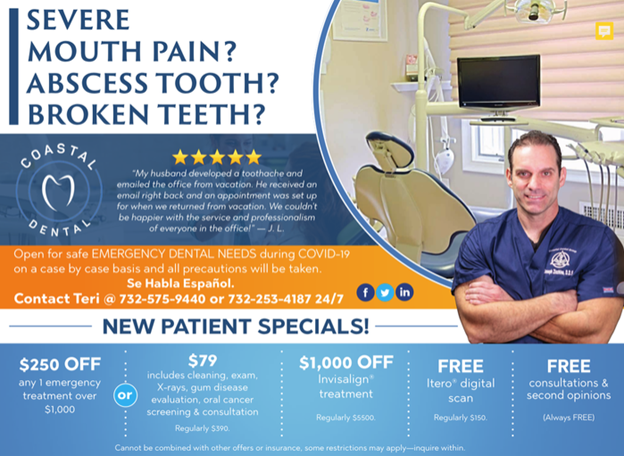
This quick-thinking certainly paid off, as the results of their campaign were:
- 23 responses, of which 11 became new patients
- $20,000 in revenue during the peak of the pandemic
Hair salons and other shops like it took a massive blow due to the coronavirus as well, with some estimates put US beauty-industry revenue at a 35% drop.
Unlike dental offices, however, hair salons were forced to close their doors entirely and had no other revenue source to sustain themselves.
When Florida began their statewide reopening plan, Hair By Katy Salon knew they needed a huge push of communication into their apprehensive community to inform them that they were open and using every COVID-19 prevention practice.
Instead of just sending out postcards, they opted for our Everywhere Small Business product, which combined the mailings:

with matching Google Ads,

Facebook Ads,
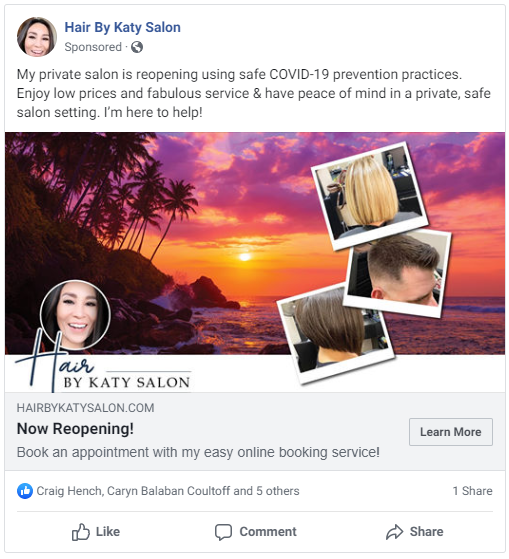
and Instagram Ads.

This integration of direct mail with digital media advertising makes a serious impact if executed correctly.
Exhibit A: The tracked results of this campaign:
- 648 clicks to their website
- 45 new clients (so far)
In this pandemic era, sometimes all it takes is a simple “we’re open” campaign to really get things rolling again for small businesses.
This family-owned removable prosthetics manufacturer was looking to find a way to generate income despite the pandemic. Although they were not directly affected by any closures, their clients, dental offices, as mentioned, were severely impacted by them.
Their issue was a little more complex than just letting the local community know that they were open. How can you influence a struggling industry to buy your products?
We worked with them to develop a COVID-19 discount package for their campaign to see if any struggling dental offices or corporations would jump at the lowered prices.
They decided on our ESB product, which sent out this card with matching digital ads.

The power of repetition in marketing truly cannot be overstated. After more than one MILLION online impressions and 491 tracked calls from postcards, these substantial results were inevitable:
- 20-30 new accounts
- $15,000-30,000 in pandemic revenue
As you can see, if there’s a will, there’s usually a way to generate revenue. Obviously, the economy and world circumstances are a MASSIVE part of this process. However, you can still find success if you just adjust your marketing strategy accordingly.
If you were looking to start your own pandemic marketing campaign, check out these 12 lessons I’ve learned from the COVID-19 crisis.
If you don’t want to bother, our marketing experts have a proven pandemic marketing track record — Call 877-438-4150 to book a free consultation.
Best,
Joy
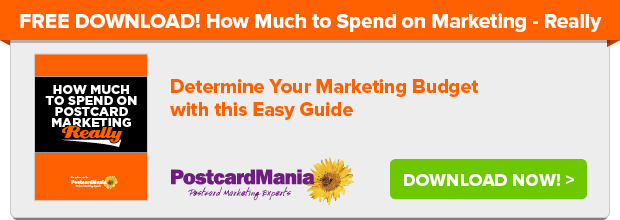
2 Comments
Amazing! That’s what I love to hear! Thanks for commenting!

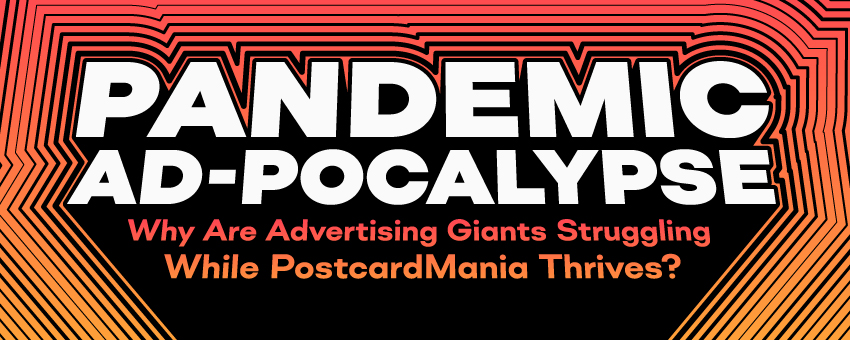



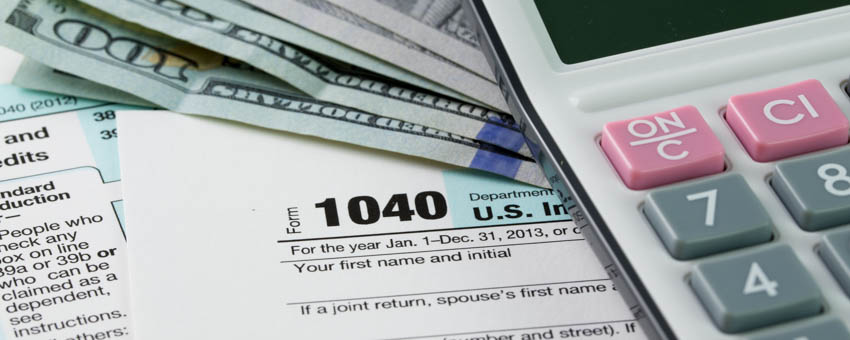
I have been in the game for 50+years, and it has never changed. In general, every dollar invested gets you back from $1.75 to $3.00 on average.